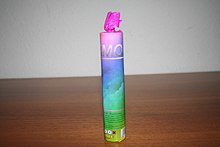| This article needs additional citations for verification. Please help improve this article by adding citations to reliable sources. Unsourced material may be challenged and removed. Find sources: "Smoke bomb" – news · newspapers · books · scholar · JSTOR (June 2009) (Learn how and when to remove this message) |


A smoke bomb is a firework designed to produce a large amount of smoke upon ignition.
History
Early Japanese history saw the use of a rudimentary form of the smoke bomb. Explosives were common in Japan during the Mongol invasions of the 13th century. Soft cased hand-held bombs were later designed to release smoke, poison gas, and shrapnel made from iron and pottery. The modern smoke bomb was created in 1848, by the British inventor Robert Yale. He developed 17th-century Chinese-style fireworks and later modified the formula to produce more smoke for a longer period.

Colored smoke devices use a formula that consists of an oxidizer (typically potassium nitrate, KNO3), a fuel (generally sugar), a moderator (such as sodium bicarbonate) to keep the reaction from getting too hot, and a powdered organic dye. The burning of this mixture boils the dye and forces it out of the device, where it condenses in the atmosphere to form a smoke of finely dispersed particles.
Home-made smoke bombs, even preceding Yale's 1848 invention, were and are most commonly used in pranks and street conflicts. They are typically made from materials that burn poorly and contained in vessels with a limited air intake that inhibit combustion. Because both the ingredients and uses are unpredictable, home-made smoke bombs are often categorized as an incendiary device.
References
- Ninja Exploding Smoke Bomb (Make Ninja Impact Smoke Bombs): Disappear Like a NINJA! by Kageboushi Clan, ASIN: B073TF95R1
- Turnbull, Stephen (2004). Ninja AD 1460 - 1650 ( ed.). Oxford: Osprey. ISBN 978-1-84176-525-9.